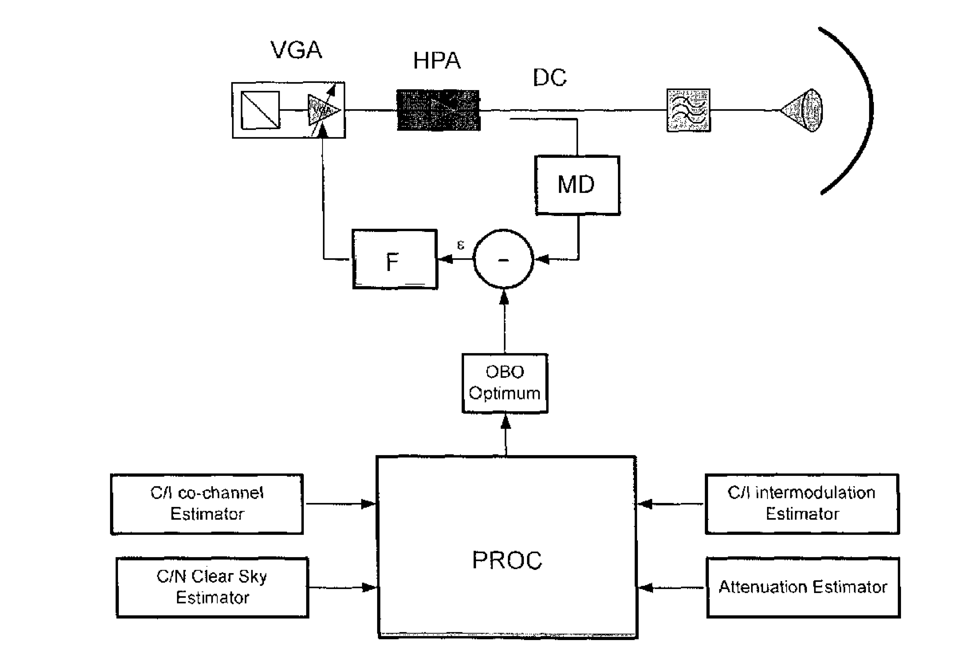Uplink power control method and apparatus for satellite communications networks
| 598 - Abstract: |
| The frequencies in which broadband satellite communications operate are becoming crowded, and industry is now looking at technologies capable of utilising higher frequencies. These are represented by the Q-band for downlink (around 40 GHz) and V-band for uplink (around 50GHz). |
ESA has developed a technology relating to a method for performing Uplink Power Control of a ground-to-satellite emitter, as well as to the development of the emitter required for the implementation of the method.
The patent technology provides the ability to achieve higher data transference rates through the use of higher frequency bands, whilst at the same time compensating for the loss of intensity in the signals that can be caused by changing atmospheric conditions (such as clouds, rain etc). This is achieved through comparing the signal intensity in “bad” conditions compared to clear sky “optimum” conditions.
Description

Future Broadband Satellite Communication Systems are targeted at achieving Terabit per second capacities in order to transmit the large amount of data required in modern communication systems. One way of achieving this target is through the extensive reuse of frequencies in multi-beam systems; however this results in extremely large bandwidth, which in turn would require the deployment of a large and costly network of Gateways (communication points).
A possible way forward to reduce the required number of gateways, and therefore minimise the cost of the ground segment of the system, is the exploitation of higher frequency bands (e.g. Q/V band) where larger amounts of bandwidths are available. Currently in Europe 4 GHz are available in Q/V band, against 2 GHz in Ka band. This factor of 2 directly translates in halving the number of required gateways, which in turn halves the ground segment cost.
Moving the feeder link towards higher frequency bands such as Q/V band though is not without its problems. The impact of atmospheric phenomena is much more critical in Q/V than in Ka band, in particular in terms of attenuation undergone by the signal when clouds or rain are present. Large fade dynamic at these frequencies risks jeopardising the availability of the link itself whenever a meteorological phenomenon such as rain occurs. The large fade dynamic requires system designers to modify some common techniques for mitigate fading events. Such techniques are commonly known as Fade Mitigation Techniques (FMT).
Uplink power control is a Fade Mitigation Technique that consists of changing the output power of a High Power Amplifier (HPA) to modify the transmitted power in order to achieve a given result. In satellite communications, Uplink Power Control in fixed links at high frequencies (i.e. Ku or higher) has been traditionally applied in such a way to compensate for the attenuation (loss of intensity) caused by atmospheric phenomena. This is done with respect to the nominal attenuation experienced by the signal in clear sky.
The presented technology consists of an Uplink Power Control method that adjusts the operating point of a High-Power Amplifier (HPA) for a ground-to-satellite emitter, as a function of the propagation attenuation. The system takes into account contributions from signal interferences as well as thermal noise and can set the operating point of the HPA at optimal operating values.
Overall the technology consists of a ground-to-satellite emitter comprising a High-Power Amplifier (HPA) and a means of control for adjusting the operating point of the HPA using the described power control method.
Innovations and advantages
The technical result of the invention, i.e. the performance gain it allows over classical Uplink Power Control, has been assessed through full system simulations based on multi-dimensional links. The system considered here is not restrictive, and the invention can be applied to very different networks, e.g. those having different topologies (star, mesh etc).
In addition this technique brings two major benefits:
- Due to the reuse of frequency in a multibeam system and due to the adjacent channels, the interference between systems is kept constant. This is valid as long as the extra attenuation does not exceed the Power Control Dynamic Range of the system.
- In clear sky, any intermodulation products and distortions generated in the gateway due to non-linearities in the amplifier are reduced.
Domain of application
- Fixed Service
- Broadband Multimedia Satellite Systems (BMSS)
- The BMSS mission is in principle associated to the multi-play services, in general, and to the 3-play in particular (Internet Access, Video on-demand, Voice over IP)
- Backbone Connectivity Network (BCN)
- High data rate
- High availability
- Service reconfiguration capability
- Broadband Multimedia Satellite Systems (BMSS)
- Mobile Service
Space Services (Data Relay)




